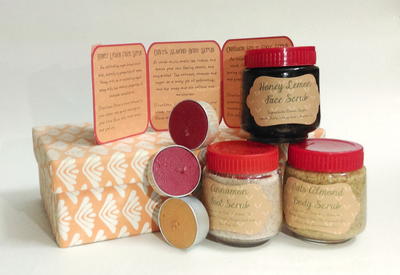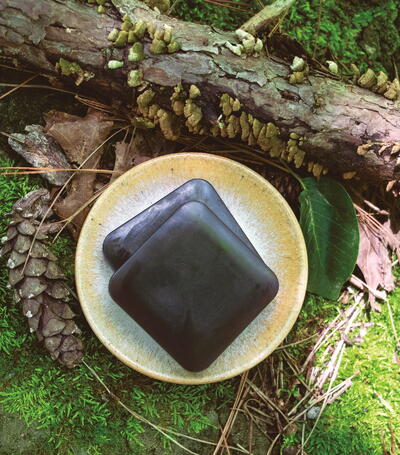Soap Making Glossary
When starting to make soap at home, you are bound to come across a few terms that you might not immediately know. In this soap-making glossary by Maria Nerius, find the definition of everything from Abrasives to Volatilization.
Abrasives: Gritty or rough substances, which are added to soap to help scrub away dirt or dead outer skin cells. Also helps remove excess oils from skin. Also considered an exfoliant. Avoid with delicate or dry skin types.
Absolute: Products, not strictly essential oils, obtained through chemical solvent extraction.
Allergy/Allergic: Hypersensitivity or reaction caused by a substance or ingredient.
Anti-oxidants: Ingredient that retards the deterioration of the soap and prevents natural/fresh ingredients from combining with oxygen and becoming rancid.
Antiseptics: Ingredients that inhibit the growth of bacteria on living tissue or in soap.
Astringents: Substances or additives to soap that tighten or close skin pores. The effect makes skin feel smoother.
Aromatherapy: Using scents or essential oils to affect mental or physical well being of person.
Aromatherapy Benefit: The emotional or physical effect evoked by aromatic essential including balance, energy, rejuvenation, cleansing, deodorizing and purifying.
Aroma/aromatic: Having scent, flavor or taste
Blenders: Additional scents that are combined with a main scent to enhance and fix the scents into a single blended fragrance.
Botanical Name: Refers to the Latin name of the plant in the biological classification system. A botanical name is composed of the genus followed by the species.
Carrier Oil: An oil base in which essential oils are diluted to create massage blends and body care products. A carrier oil has little or no scent.
Dermal: Pertaining to the skin.
Disinfectant: Prevents or combats the spread of germs.
Enfleurage: Age-old method of extracting essential oils using odorless fats and oils to absorb the oil from the plant material.
Essential Oil: Highly concentrated, volatile, aromatic essences of plants.
Emollients: Additives that soften skin.
Expression: Method of obtaining essential oil from plant material, such as citrus fruit peel. The complete oil is physically forced from the plant material. Also known as cold press extraction.
Extraction Method: The method by which essential oils are separated from the plant. Common extraction methods include distillation, expression and solvent extraction.
Fillers: Ingredients that add bulk or extend a soap.
Fixatives: Ingredients that stabilize volatile oils and prevent them from evaporating too quickly.
Food Grade: Safe for use in food by the Food and Drug Administration.
Fragrance Oil: Fragrances and scents derived by synthetic means.
Herbal: Pertaining to natural botanicals and living plants.
Holistic: A natural approach to healing outside Western medicine conventions.
Homeopathy: Therapy using plant, animal and mineral substances in dilutions to overcome illness by stimulating the body's natural immunity.
Hydrating: Restoring or maintaining normal proportion of fluid in the body or skin.
Insoluble: Unable to be dissolved in a liquid such as water.
Irritant: Substance or material that produces irritation or inflammation of the skin.
Main Scent: Dominant scent to which other scents can be added to create a new single blended scent.
Nervine: Strengthening or toning the nerves or nervous system.
Olfactory: Relating to or connected with the sense of smell.
Potpourri: Fragrant mixture of dried herbs and flowers. Usually scented with synthetic fragrance oils.
Relaxant: Ingredient that is soothing, relieving strain or tension.
Refrigerant: Ingredient that cools inflammation or eases muscle pain.
Sedative: Ingredient that reduces functional activity or calms.
Single Note: Pure, 100% natural essential oil: no additives; no adulterations.
Soluble: Able to be dissolved in a liquid such as water.
Stimulant: Ingredient or substance that temporarily speeds the functional activity of a human tissue.
Synergistic: Characteristic in which the total effect is more effective than the individual parts.
Synergistic Blend: Combination of multiple essential oils that produce a completely new aroma with a different therapeutic effect.
Synthetic: Artificially produced substance designed to imitate that which occurs naturally.
Rendering: Impurities in animal fats are removed during this process over heat creating tallow which is pure fat used in soap making.
Viscosity: Pertaining to the thickness or thinness of a liquid.
Volatile: Essential oils that evaporate very easily or quickly. Fixatives stabilize oils and result in a longer lasting scent.
Volatilization: Rate of evaporation or oxidation of an essential oil.
Wild: Growing spontaneously, not cultivated.
Your Recently Viewed Projects
Weberme
Feb 09, 2017
I have not seen a soap making glossary anywhere and have been looking each one up separate and this is so great that they are all in one place to keep the list handy because there is a lot to take in when making soap and this list helps a lot. Thanks a lot. Anyone else agree?
Report Inappropriate Comment
Are you sure you would like to report this comment? It will be flagged for our moderators to take action.
Thank you for taking the time to improve the content on our site.
















